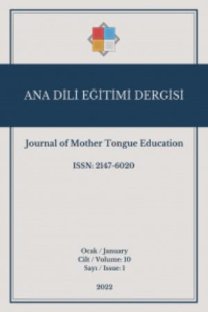Teaching Reading and Writing in Mother Tongue for Children with Visual Impairments
___
American Printing House for the Blind (1991). Distribution of federal Quota Based on the Registration of Eligible Students. Louisville, KY: Author.Adams, M. J. (1990). Beginning to read: Thinking and learning about print. Cambridge, A.M. Massachusetts Institute of techonology Press.
Bain, R. - Fitzerald, B. - Taylor, M. (1992) (Eds), \"Looking into Language\", Hodder & Stroughton, London.
Barraga, N. C. & Erin, J. (1990). Visual Handicaps and learning. Austin: ProEd.
Berkeley, G. (1709/1974). An essay towards a new theory of vision. In D.M. Armstrong (eds.) Berkeley\'s Philosophical Writings. New York: Collier.
Daneman, M. (1988, November 16). How reading braille is both like and unlike reading print. Memory and Cognition, 16, 497-504.
Drakos D. J. (2003). Special Education of Speech Problems.
Emmit, M. - Pollock, J., (1991). \"Language and Learning\", Oxford University Press Australia, Melbourne.
Foulke, E. (1982). Reading braille. In W. Schiff & E. Fooulke (Eds.), Tactual perception: A sourcebook (pp 168-208). New York: Cambridge University Press.
Gibson, J. J. (1962). Observations on active touch. Psychological Review, 69, 6, 477-491.
Gibson, J. J. (1966). The Senses Considered as Perceptual Systems. Boston: Houghton Mifflin.
Grunwald, D. (1966) A braille reading Machine. Science, 154, 144-146.
Halliday, M.A.K. - Hasan, R.,(1985). \"Language, Context and Text: Aspects of Language in a Social - Sermotic Perspectives\", Deakin University, Geelong, Vic.
Harley, R. K., Truan M. B. & Sanford L. D. (1997). Communication Skills for Visually Impaired Learners (2nd ed.). Charles C Thomas Publisher LTD.
Heller, M. A. (1989). Texture perception in sighted and blind observers. Perception & Psychophysics, 45, 49-54.
Hiebert, E. H. (1988). The role of literacy experiences in early childhopod programs. The Elementary School Journal, 89 (2), 161-171.
Katz, D. (1925). Der Aufbau der tastwelt. Leipzi: Barth.
Klatzky, R. L, Lederman, S. J. & Metzger, V. (1985). Identifying objects by touch: An \"expert\" system. Perception And Psychophysics, 37, 299-302.
Kusajima, T. (1974) Visual reading and braille reading: An experimendal investigation of the physiology and psychology of visual and tactual reading. New York: American Foundation for the blind.
Lamb, G. (1996). Beginning Braille: A Wholl Language-based Strategy. Journal of Visual Impairment & Blindness, 90 (3), 184-189.
MacComiskey. A. V. (1996). The Braille Readiness Skills Grid: A Guide to Building a Foundation for Literacy. Journal of Visual Impairment & Blindness, 90 (3), 190-194.
Millar S., Ballesteros, S. & Reales, J. M. (1994). Influance of symmetry in haptic and visual perception. 35th Annual Meeting of the Psychonomics Society, St Louis.
Millar, S. (1997). Reading by touch. London: Routledge.
Nolan, C. Y. & Kederis, C. J. (1969). Perceptual factors in Braille Recognition. New York: American Foundation for the Blind.
Papadopoulos S. K. (2005) Blindness and Reading, Reading by Touch.
Piaget, J. (1953). The origin of intelligence in the child. London: Routledge & Kegan Paul.
Revesz, G. (1950). The psychology and art of the blind. London: Longmans Green.
Simon, C., & Huertas, J. A. (1998). How Blind Readers Perceive and Gather Information Written in Braille. Journal of Visual Impairment & Blindness, 92 (5), 322-331.
Wardhaugh, R., (1992). \"An Introduction to Sociolinguistics\", 2nd ed., Blackwell, B., Oxford, U.K.
Warren, (1982). The development of haptic perception. In W. Schiff & E. Foulke (Eds.), Tactual perception: A sourcebook (chapter 3). New York: Cambridge University Press.
Wilkinson. L. C., (1982). \"A Sociolinguistic Approach to Communicating in the Classroom\", in Wilkinson L. C. (Ed), \"Communicating in the Classroom\", Academic Press, New york, 3- 11.
Zoniou - Sideri A. & Spandagmou H. (2011). Education and Blindness.
- ISSN: 2147-6020
- Yayın Aralığı: 4
- Başlangıç: 2013
- Yayıncı: Mehmet Kurudayıoğlu
Bakhtin's Influence: ? Dialogic Approach to Teaching of Argumentation
Teaching Reading and Writing in Mother Tongue for Children with Visual Impairments
Gönderilme: Kasım 2015 / Düzeltme: Aralık 2015 / Kabul Edilme: Aralık 2015
Nikoletta MALLİDİS TSİTSANOUDİS
Bakhtin's Influence: ? Dialogic Approach to Teaching of Argumentation
Yansıtıcı Günlük Yazma Uygulamasına İlişkin Öğrenci Görüşleri***
Mikro Öğretim Tekniğinin Türkçe Öğretmen Adaylarının Konuşma Becerilerine Etkisi
